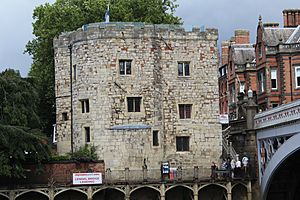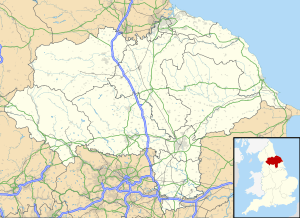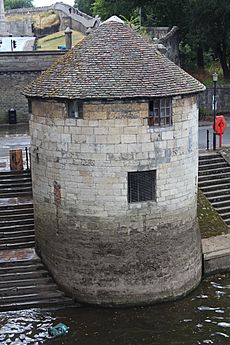Lendal Tower facts for kids
Quick facts for kids Lendal Tower |
|
|---|---|
| Part of York city walls | |
| York, England | |

Lendal Tower in July 2018
|
|
| Coordinates | 53°57′37″N 1°05′14″W / 53.9603°N 1.08717°W |
| Type | Tower |
| Site history | |
| Materials | Magnesian limestone |
|
Listed Building – Grade I
|
|
| Official name: Lendal Tower | |
| Designated: | 14 June 1954 |
| Reference #: | 1257086 |
Lendal Tower is an old tower built a long time ago. It was part of the city's defenses in York, England. You can find it on the east side of the River Ouse. It's right where the river flows into the walled city from the north-west.
For many years, from 1616 to 1846, the building was used as a waterworks. This means it helped supply water to the city. After that, it became offices. Today, it has been turned into homes that people can rent.
Contents
The Tower's Story: How it Changed Over Time
Lendal Tower was built around 1300. When it was first built, it was round. It looked a lot like Barker Tower, which is also called the North Street Postern Tower. Over time, Lendal Tower was changed. It was made stronger and taller.
Lendal Tower and Barker Tower were built to control who came into the city. A big iron chain was stretched across the river between them. This chain made sure people paid a fee to enter. From medieval times until 1863, a ferry service also crossed the river between the two towers.
The tower is first mentioned in records from 1315. It was called Turrim Sancti Leonardi, which means "Tower of St Leonards." In 1569, extra defenses were added to the city walls. This was to protect against rebel groups. Repairs were also done to the tower in 1584 and 1585.
Lendal Tower as a Waterworks
Starting in 1616, the tower was used to help bring piped water to the city. It was made taller in 1616. Pictures from 1678 show it had three floors. These pictures also show that the tower was in bad shape. This might have happened during a big battle called the Siege of York in 1646.
The tower became known as 'the waterhouse'. In 1677, a new plan was made for its use. The tower was rented out for 500 years for a very small fee. Permission was given to make improvements. In 1682, the building was made bigger and stronger. This was to hold a large lead tank for water.
At first, water was pumped in using a windmill or a waterwheel. But this didn't work very well. After a few years, a horse engine was put inside the tower instead.
Modern Changes and Uses
More big changes happened in the 1750s. A steam engine was put in. This engine was rebuilt in the 1780s by John Smeaton. More parts were added to the building at this time. Hot and cold baths were also built in a building next to the tower.
The engine was moved to a nearby engine house in 1836. Then, in 1846, the waterworks moved to a new place called Acomb Landing. Lendal Tower was made shorter and changed by G.T. Andrews. He made the tower look more medieval by adding the crenellations, which are the notched tops you see on old castles.
The waterworks company kept the tower. In 1932, they turned it into their offices. In 1954, it was named a Grade I listed building. This means it's a very important historic building. It's also protected as a scheduled monument because it's part of the city's old defenses. Since 2010, it has been fixed up and is now rented out as homes.
What Lendal Tower Looks Like
Lendal Tower was first a round building. It was about 28 feet (8.5 meters) wide. It had a small round turret that held a wooden spiral staircase. In the 1600s, a rectangular part was added to the south-east side.
The building is made of Magnesian limestone. Some of this stone might have come from the nearby St Mary's Abbey. This abbey was closed in 1539. Its stones were later used for many buildings in York.
The tower has crenellated walls, which were added in 1846. It also has a copper roof that has been turned into a roof terrace. Inside, the brickwork was used to support the engines from the 1700s. A lift was put in during the 1932 repairs. At that time, Jacobean style decorations and wood panels were also added.



